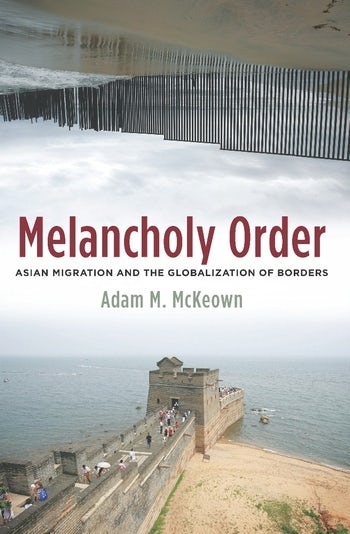Melancholy Order
Asian Migration and the Globalization of Borders
Columbia University Press

Melancholy Order
Asian Migration and the Globalization of Borders
Columbia University Press
As Adam M. McKeown demonstrates, the push for increased border control and identity documentation is the continuation of more than 150 years of globalization. Not only are modern passports and national borders inseparable from the rise of global mobility, but they are also tied to the emergence of individuals and nations as the primary sites of global power and identity.
McKeown's detailed history traces how, rather than being a legacy of "traditional" forms of sovereignty, practices of border control historically rose from attempts to control Asian migration around the Pacific in the 1880s. New policies to control mobility had to be justified in the context of contemporary liberal ideas of freedom and mobility, generating principles that are taken for granted today, such as the belief that migration control is a sovereign right of receiving nations and that it should occur at a country's borders.
McKeown shows how the enforcement of these border controls required migrants to be extracted from social networks of identity and reconstructed as isolated individuals within centralized filing systems. Methods for excluding Asians from full participation in the "family of civilized nations" are now the norm between all nations. These practices also helped institutionalize global cultural and economic divisions, such as East/West and First and Third World designations, which continue to shape our understanding.
McKeown's detailed history traces how, rather than being a legacy of "traditional" forms of sovereignty, practices of border control historically rose from attempts to control Asian migration around the Pacific in the 1880s. New policies to control mobility had to be justified in the context of contemporary liberal ideas of freedom and mobility, generating principles that are taken for granted today, such as the belief that migration control is a sovereign right of receiving nations and that it should occur at a country's borders.
McKeown shows how the enforcement of these border controls required migrants to be extracted from social networks of identity and reconstructed as isolated individuals within centralized filing systems. Methods for excluding Asians from full participation in the "family of civilized nations" are now the norm between all nations. These practices also helped institutionalize global cultural and economic divisions, such as East/West and First and Third World designations, which continue to shape our understanding.
Here is a wise and provocative book for all who seek to understand why human migrants face increasing hostility, stricter restrictions, and intensifying border controls. Melancholy Order will be required reading for world historians of international migration, international law, and the impact of nationalism and racism on their intersection. Adam M. McKeown brilliantly synthesizes years of reading and research in archives on several continents, tracing the origins of today's debates to the erection of Chinese migration barriers by the liberal democracies of the nineteenth and twentieth centuries. His analysis of the subsequent spread and expansion of restrictions provides a cautionary tale: there will be no easy answers to contemporary debates about migration. Donna Gabaccia, professor of history and director, Immigration History Research Center, University of Minnesota
Adam M. McKeown's provocative study clarifies how the regulation of migration was crucial to the development of modern conceptions of sovereignty and how Asian exclusion was the chief crucible from which relevant international identity documentation emerged in the late nineteenth century. Melancholy Order is a major contribution to a truly global understanding of the history of migration as well as a challenge to the typically ahistorical and Eurocentric conception of 'globalization.' Essential reading both for historians of migration and for those in the social sciences who want to make sense of what is (and isn't) really new in the contemporary period. John Torpey, professor of sociology, CUNY Graduate Center
An important new work in the field of transnational history and migration studies... Highly recommended. Choice
An insightful and deeply engaged excavation of international methods of constraint and identification that have attained naturalized status today. Madeline Yuan-Yin Hsu, American Historical Review
A highly important and invaluable contribution to the often US-centered perspectives concerning migration control and Chinese exclusion. Barbara Luthi, H-Soz-u-Kult
[A] well-documented and closely argued intervention in global history, full of remarkable insights. Evelyn Hu-DeHart, Journal of American History
Required reading for any scholar who is interested in the history of migration control. Erika Lee, Journal of Asian Studies
In this book, McKeown demonstrates fully his broad readings and knowledge of works in this field. Kwee Hui Kian, Journal of World History
List of Tables and Figures
Acknowledgments
Introduction: The Globalization of Identities
Part I: Borders in Transformation
1. Consolidating Identities, Sixteenth to Nineteenth Centuries
2. Global Migration, 1840–1940
3. Creating the Free Migrant
4. Nationalization of Migration Control
Part II: Imagining Borders
5. Experiments in Border Control, 1852–1887
6. Civilization and Borders, 1885–1895
7. The "Natal Formula" and the Decline of the Imperial Subject, 1888–1913
Part III: Enforcing Borders
8. Experiments in Remote Control, 1897–1905
9. The American Formula, 1905–1913
10. Files and Fraud
Part IV: Disseminating Borders
11. Moralizing Regulation
12. Borders Across the World, 1907–1939
Conclusion: A Melancholy Order
Primary Sources and Abbreviations Used in Notes
Notes
Index
Acknowledgments
Introduction: The Globalization of Identities
Part I: Borders in Transformation
1. Consolidating Identities, Sixteenth to Nineteenth Centuries
2. Global Migration, 1840–1940
3. Creating the Free Migrant
4. Nationalization of Migration Control
Part II: Imagining Borders
5. Experiments in Border Control, 1852–1887
6. Civilization and Borders, 1885–1895
7. The "Natal Formula" and the Decline of the Imperial Subject, 1888–1913
Part III: Enforcing Borders
8. Experiments in Remote Control, 1897–1905
9. The American Formula, 1905–1913
10. Files and Fraud
Part IV: Disseminating Borders
11. Moralizing Regulation
12. Borders Across the World, 1907–1939
Conclusion: A Melancholy Order
Primary Sources and Abbreviations Used in Notes
Notes
Index
Read an excerpt from the introduction >The Globalization of Identities. (pdf)
